A journey across cities: A re-encounter with the women of ‘Dhobi Ghat’

By Saumya B Verma
“A city like Bombay, like New York, that is a recent creation on the planet and does not have a substantial indigenous population, is full of restless people” (Suketu Mehta, Maximum City: Bombay Lost and Found)
So, what do restless women do to put their minds to peace?
I migrated to New York last year. Besides constant buying, unpacking, sorting, and arranging the nitty-gritties of a new life, the first few months of my trans-Atlantic move were marked by an avid and sometime compulsive binge-watching on Netflix and Amazon. During such nonstop video-streaming, I often wondered if Ashima Ganguli would have lived a different life in The Namesake if she had access to Netflix or Amazon? I take pride in being an informed spectator of world cinema and television (and some sort of a scholar, too) and yet the seduction of Indian films is tough to fight. Evoking sights, sounds, and smells of a land you were born in, and currently miss while finding your feet in a new city of the world, films from home always hold a special place in my must-watch list. In one such, now habitual watch-fest, I re-discovered Kiran Rao’s Dhobi Ghat – Mumbai Diaries. Even as I finished watching Netflix’s much hyped ‘Wild Wild country’, I played Dhobi Ghat as a reminder of the ‘real’ India that I thought I was missing. To my surprise, I re-discovered a narrative of unsettlement, conflict, and transition that I had seen some seven years ago and pretty much forgotten about it. A film based in Mumbai and completely shot on-location, Rao’s Dhobi Ghat – Mumbai Diaries has variously been hailed as an ode to Mumbai, a sensitive film about class, a contemporary art-house gem, etc. Rao herself described it as a film about ‘many Mumbais’ made in a mould that’s not ‘cookie cutter’ style, otherwise typical to Bollywood film industry.
In an interview to The Express Tribune, months before the film was released in January 2011, Rao described her directorial debut as an attempt “to focus on the unending movement of city living; of life in a world of 11-month leases and having to live with the leftovers of other people’s lives…So Dhobi Ghat is a collage of this city. It is about the contradictions of modern existence.”
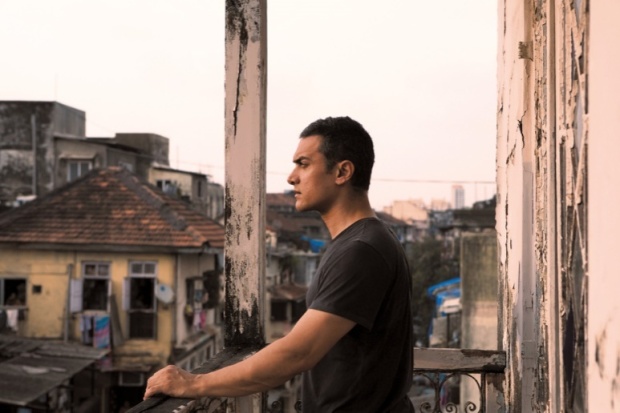
Shot mostly in dilapidated yet often romanticised old quarters of the city and around a few historical landmarks like the Gateway of India and Elephanta caves, the film uses the city skyline as a visual motif that binds the lives of its four major characters – Shai, Yasmin, Munna, and Arun. Lot of international critics compared Dhobi Ghat to Danny Boyle’s Slumdog Millionaire, which was shot mostly in Mumbai slums. However, they were quick to qualify, like this one at National Public Radio, USA: “This is no Slumdog Millionaire, yet for all its shortcomings, Dhobi Ghat seethes with raw, atmospheric vitality and an ingenuous charm that trumps the glib visual grandstanding of Danny Boyle’s undeniably entertaining movie, whose kinetic restlessness goosed its audience into a state of undiscriminating excitation without ever embracing the city in all its multiplicity.”
While you catch your breath after reading that infinitely pithy prose of criticism, one ambition that surely forms the core of city experience in Dhobi Ghat is embracing Mumbai in all its multiplicity and layered nuances. Whether the film succeeds in living up to its own challenge or not, that’s another question for another day!

First ten minutes into the narrative, the film introduces all the four major characters – Shai (an investment banker cum amateur photographer, played by Monica Dogra), Yasmin (a newly wedded housewife, played by Kriti Malhotra), Munna (the local ‘dhobi’ with Bollywood aspirations, played by Prateik Babbar), and Arun (the reclusive yet renowned painter, played by Aamir Khan). While all of them represent a different class, gender, and community – the hallmark multiplicity of this megacity – all of them also have something in common.
They are all outsiders. They are all migrants, some sort or the other.
Interestingly, the film has never been overtly critiqued or talked about as a film about migration experience. It was perhaps my new-found identity of an emigrant, an NRI that enabled a new point of view. I had seen and read about the film as largely a study in modern urban experience, a nuanced depiction of class in contemporary India, a visual essay on ‘Maximum City’, etc. However, my new context marked by my re-location and displacement made me re-visit Dhobi Ghat through a new filter. I started seeing the two women protagonists of the film not just as women characters lodged in a narrative of urban restlessness but as women migrants negotiating and living their experience of displacement. Their attempt to understand their relationship to this city that once perhaps was their home (Shai) or is the space for their future destinies (Yasmin).
Shai is a Non-Resident Indian who works as a banker in New York and is visiting Mumbai during a sabbatical. When we first meet her in the film, she is visiting an art exhibition by an acclaimed artist, Arun, in one of the upscale art galleries of Mumbai. It’s interesting how this sequence, right at the beginning of the film, delineates some of the over-arching themes of the film. Arun’s painting exhibition is titled ‘Buildings’. He describes it as a tribute to migrant labourers from different parts of India such as Uttar Pradesh, Tamil Nadu, Andhra Pradesh, Madhya Pradesh, etc., who travel to the ever-expanding metropolis in search of work and livelihood and who build the physical,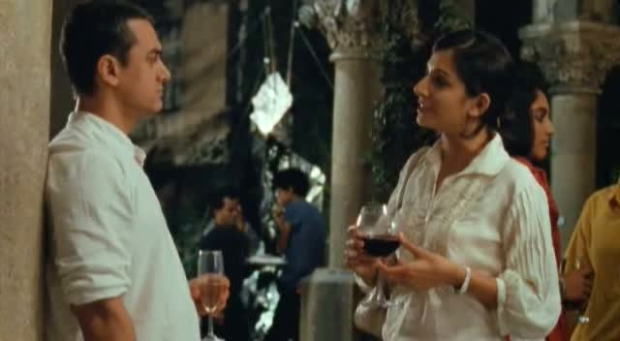 material structures of the city. These material structures in turn shelter more migrants who dream of making it big in this ‘promised land’ that seduces them with the prospect of fame, money, and romance. Arun raises a toast to the city of Mumbai – his ‘whore, beloved and muse’. Arun’s appreciation and sympathy for the uprooted migrant appeals to Shai, herself a displaced citizen of the global economy. In her first meeting with the painter, Shai sounds elated about being in Mumbai as it gives her an opportunity for ‘change of air’ and indulge in her hobby for photography. She is also quick to add that it isn’t a mere vacation for her. She is working on a funded project to document small-scale businesses in the city during her sabbatical. Arun and Shai’s first meeting ends in a one-night stand at Arun’s rented apartment. Their relationaship, besides few interrupted encounters, remains largely unresolved and uncertain in the film.
material structures of the city. These material structures in turn shelter more migrants who dream of making it big in this ‘promised land’ that seduces them with the prospect of fame, money, and romance. Arun raises a toast to the city of Mumbai – his ‘whore, beloved and muse’. Arun’s appreciation and sympathy for the uprooted migrant appeals to Shai, herself a displaced citizen of the global economy. In her first meeting with the painter, Shai sounds elated about being in Mumbai as it gives her an opportunity for ‘change of air’ and indulge in her hobby for photography. She is also quick to add that it isn’t a mere vacation for her. She is working on a funded project to document small-scale businesses in the city during her sabbatical. Arun and Shai’s first meeting ends in a one-night stand at Arun’s rented apartment. Their relationaship, besides few interrupted encounters, remains largely unresolved and uncertain in the film.
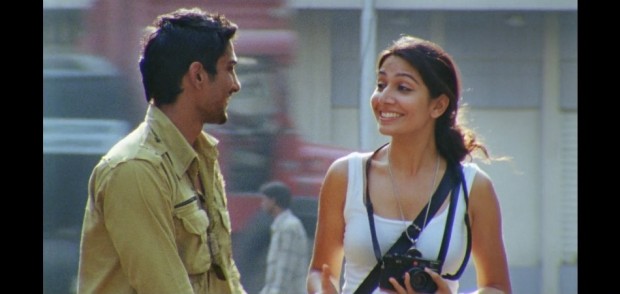
For her project and as an aide to navigate the city, Shai enlists the company of her young dhobi, Munna. A native of Bihar, guileless Munna falls for Shai from the word go! Confused by Shai’s unusual frankness, Munna is tempted to but eventually never crosses the class barrier and maintains his distance. Meanwhile, Shai’s attempt at photographing the city and a constant quest for the photogenic impart her sort of a touristy gaze in her own land. But then, does Shai even consider Mumbai as her own land (an assumption that doesn’t seem so fallacious when one witnesses her virtually deliberate naïveté at social etiquette)? Even beyond her noticeable accent, she is perhaps more American than Indian (a sentiment echoed by Munna quite often). An emigrant revisiting her roots or just a tourist mesmerized by an incredible city? Or somewhere in between?
The other woman protagonist of the film, Yasmin has just re-located to Mumbai from Malihabad (the small north Indian town famous for its mangoes). It’s through Yasmin’s shaky handycam that we get our first glimpse of a rain-soaked, bustling Mumbai as the film opens. However, she soon disappears to be discovered later in the narrative. She is only five months old in a city that overwhelms her through its chaotic crowds and frenetic pace. A newly wedded Muslim bride, Yasmine’s voice-over, while she chronicles the city on her camera, seems to take on a classical choral quality. Hailing from a landlocked Indian town, she is not wooed over by the Mumbai sea. The salty sea breeze feels heavy to her with the smell of people’s dreams and desires. Much of our interaction with Yasmin is through her video-diary that she records regularly and plans to post to her younger brother in Malihabad. Due to a tragic turn of events, she never gets to post these tapes as we find later in the film. She was a tenant in the same house that Arun rents in the film. After moving into the house, Arun discovers a small box in the clothes closet. The box contains a few trinkets and three video tapes. When he plays the tapes, Arun lets us into the private world of Yasmin.

Yasmin and Shai both represent diverse impulses and trajectories of migration. Shai moved away from Mumbai to New York for reasons of education and profession, while Yasmin’s move is necessitated by a different reason. She belongs to the largest group of migrants in India – the married women. Her move is a result of her new social status as a wife. Both the women occupy different positions of privilege and class. Shai’s father is a builder who controls premium real estate in Mumbai and her mother is an avid art collector. Architecture and art, I thought while watching the film, usually the first routes into discovering a new city. Even before I moved to New York, I was familiar with the famous skyline of the megapolis. And one of the first things on my to-do list was to visit some of the landmark buildings and museums in the city.
While we do not know much about Yasmin’s family in Malihabad, she is a housewife in Mumbai, financially dependent on her middle class, largely indifferent husband.
Both Shai and Yasmin make us ‘see’ the city quite literally through their cameras. The use of a variety of cameras, still or video, other kinds of visual forms like paintings and movies within the diegesis of the film and the use of different formats (16mm film) or modes (handheld) of shooting the film itself, constitute a larger project of ‘ways of seeing’ the city by the director.
Yasmin and Shai, in parts, seem to represent Rao’s ambition ‘to focus on the unending movement of city living’. However, the filmmaker seems to have assigned different prisms to these characters for looking at the city, something that feels too pat at times.
Shai’s reasons to photograph the city are entrenched in, and at the same time reveal economic compulsions of modern urban life. She is ‘studying’ the small-scale businesses and marginalised economic enterprises. Guided by her larger professional ambition as an international banker and her perpetual quest for the photogenic, she introduces us to sights from Dhobi Ghat, subzi mandi, Bhendi bazaar – all spaces of commerce in this financial capital of India. Hers is not an aimless ‘flânerie’, she is a woman with purpose.
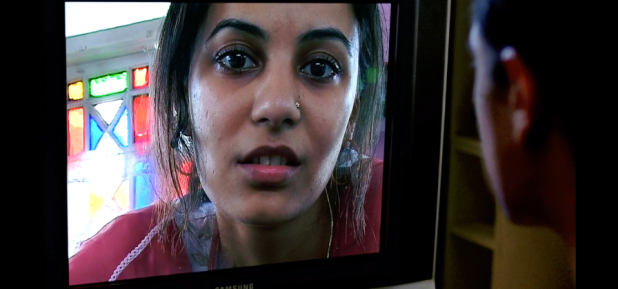
On the other hand, Yasmin, located in a middle-class domestic space, views the city through a more personal prism. Through these two women, the narrative seems to set up an arc of classic ghare-baire (home-outside). Yasmin is firmly framed in the realm of ghare – home.
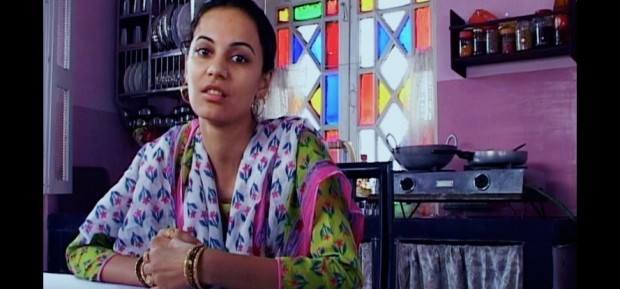
Yasmin’s three most critical sequences – her self-introduction, her revelation of the love-less marriage, and finally her tragic confession – all reveal a frame where images of domesticity like a cooking stove, utensils, refrigerator, dining table, etc. are central to the mise-en-scène. Her narration invariably revolves around food, relatives, her husband, family celebrations, festivals, her childhood, and more intimate conversation about her personal life in the city. While Shai takes up the role of an observer and recorder, Yasmin, right from the start, emerges as a commentator who interprets the images surrounding her. Watching her neighbour hastily cook and pack lunch-tiffins in the mornings, she ruefully remarks how the accelerated life in Mumbai forces its people to sacrifice zayka (taste) in favour of speed. She feels homesick and her constant references to her past in Malihabad reveal her isolation in this new city and growing nostalgia for an unhurried life that she no longer has access to. Even before she can try to blend in, she feels rejected. She craves for the relaxed, nourishing vitality of her hometown that she begins to miss more intensely as her husband casts her away. While we watch Arun watching Yasmin’s video-diary, we receive her existence as a recording, a retrospective, a memory. Hers is a project of seeing (the city) and memorialising (herself) at the same time. Her loneliness is complete as the film camera frames her close-up on a screen within a screen. She is twice removed. Her alienation in the city drives her to death.
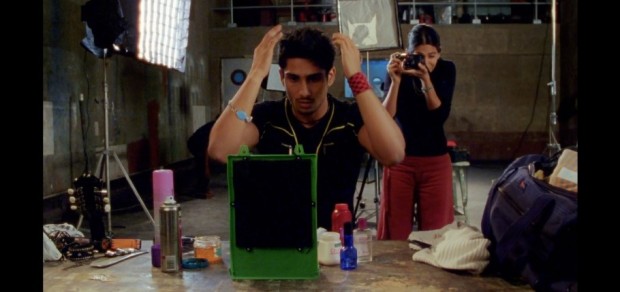
While we do get a peep into Yasmin’s inner world through her video-diaries, Shai’s mindscape remains distant and inaccessible even as she almost obsessively shoots the city. Unlike Yasmin, Shai belongs to baire – outdoors. She goes out, makes new friends, hangs out with older ones, talks to local traders, interviews them, savours local street food, ventures out to shoot the streets in the night, and enjoys Mumbai’s rains. By agreeing to shoot a picture portfolio for Munna, Shai even manages to reverse the conventional male gaze temporarily. However, after a point, her strange fixation on Arun and constant need for Munna’s company seem to reveal a certain ennui towards her own life. Shai’s nearly compulsive navigation of the city seems like an attempt to counter a certain emptiness inside. Perhaps in her own in-betweenness, of being with Munna but longing for Arun, of being there in the city but not belonging. She calls out to the city to fill that empty space inside her. And the city obliges. The city does become the fifth character in the narrative in so many ways.
While I grapple with my own realities and memory-making in the new city, I identify with both Shai and Yasmin but only in parts. I continue my encounters with the city in both the domestic and professional realms – doing rapid rounds of groceries, cooking copious amounts of food, cleaning and washing, watching neighbours shovel their driveways and on other sunny days visiting film festivals, attending courses at the university, volunteering in the community, reading new authors, making new friends! I empathise with Yasmin. I relate to her loneliness. I admire Shai and her affinity to outdoors excites me. As I encounter the ‘leftovers of other’s lives’ in my new house, I also try to connect to a new character in my life – the city of New York. And yes, I continue to watch more films, this time not just from Mumbai, Chennai or Calcutta but from Milan, London, Paris, Rio and New York, too!
Bio:
Saumya B Verma is a media professional and an academic. Currently exploring the many wonders of New York City, she has worked with Microsoft, NDTV, and Star World in the past. She has also taught at some of India’s top media and business schools such as AJK MCRC-JMI, Delhi University, and IIM Ahmedabad in the past.
***
For more stories, read Café Dissensus Everyday, the blog of Café Dissensus Magazine.






You have truly done justice to the film’s attempt to canvas a metropolitan in India. Thanks for writing such a great review!
I have such fond memories of watching it at the time of its timely release in early 2011. It was a breath of fresh air in the microscopic mosaic it painted with such realism. The microcosm of Bombay was portrayed beautifully. However, the one individual who stood out for me was the immobilized old lady who never spoke and occupied the neighboring flat in the building on Mohammed Ali Road where Aamir Khan’s painter comes to stay. What could have possibly stilled her like an ancient stone or was it the stomp of age and time. A fascinating person – really a micro world in a city of multiple macros. Of course the unraveling of the wife was realized potently. The film, for me, was away from the glaring eye and intimately highlighted the detached, curdled air of melancholy in the women and individuals.
You have written a piece which is realistically pegged between the actually realized and vicarious and the manner of seamlessly broaching a middle path has been successful. It’s an evocative piece of writing.